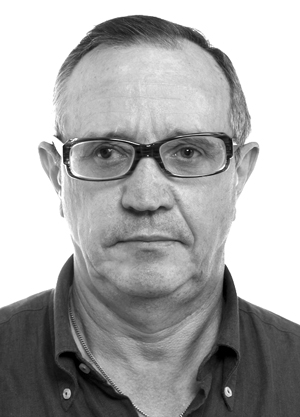Comprehensive evaluation of sports capabilities of strongest rowers and canoeists of Belarus
Фотографии:
ˑ:
Professor, Dr.Biol. V.Yu. Davydov
Associate professor, Ph.D. E.G. Kallaur
Head coach of Rowing and Canoeing National team, Associate Professor V.V. Shantarovich
Associate professor, Ph.D. S.V. Vlasova
Associate professor, Ph.D. V.V. Marinich
Associate professor, Ph.D. A.Yu. Zhuravskiy
Associate professor, Ph.D. O.O. Kuraleva
Polessky State University, Republic of Belarus
Ministry of Sport and Tourism, Republic of Belarus
Astrakhan State Technical University, Astrakhan
Keywords: sports qualification, integrated assessment, rowing and canoeing, anthropometric indices, functional state, oxygen consumption, myocardial contractility, genetic polymorphisms, intermuscular coordination, electroneuromyography.
Introduction. The issue of sports qualification and selection is one of the main theoretical and practical biomedical problems of physical culture and sport. Development of the theory of sports qualification has its effect on the level of performance and development of sport science in general. The purpose of sports activity is to achieve a maximum possible sports result specific for an individual. In this view, the study of athletes' individual capabilities is of current interest.
Growth of performance in most sports, including rowing and canoeing, requires further study of athletes' individual capabilities.
Estimation of individual capabilities and allocation of promising athletes in the contemporary conditions of elite sport assume special significance, thus promoting an increase of efficiency of training process [3, 5].
In the contemporary conditions of elite sport, it becomes increasingly important to spot the most gifted, perspective athletes, as record achievements are specific for athletes with the most optimal indices typical for the given sport. On the one hand, athletes differ by their morphological, functional, psychological characteristics, adapt to different work conditions in different ways, on the other hand, a goal-oriented activity affects selection of the most gifted athletes and formation of their specific morphofunctional status [6].
Numerous research works reveal that higher qualification in cyclic sports promotes higher cardiac index (CI) and a more significant increase of the stroke volume index (SVI) of an athlete [1]. Formation of SVI is much influenced by the circulating blood volume, myocardial contractility (MCI and IIS), BP, vascular resistance, pre-ejection period (PEP) and left ventricle ejection time (VET) [8]. Regular long-term sports training sessions result in the cardiac mass growth, which is accompanied by an increase in the end-diastolic index (EDI), hypertrophy of the ventricular septum and left ventricle posterior wall [9]. Myocardial hypertrophy in athletes leads to an increase of SVI, maximum CI and low HR at rest.
Owing to this, diastolic time extends both in a relaxed state and during submaximal physical loads, which enhances the myocardial perfusion [11]. The increase of DО2I up to the normal level predominantly eliminates the deficit of O2 in the tissues. The deficit of O2 consumption activates anaerobic glycolysis which partially compensates for the lack of ATP, and supports the normal cell activity for a limited period of time. Continuous preponderance of anaerobic glycolysis leads to a pronounced cell dysfunction. Normally, high muscle loads result in capillary proliferation in the skeletal and cardiac muscles with an increase in the number of capillary tubes and oxygen delivery (DO2I) [1], formation of a specific pattern of intermuscular coordination and operation of the central and peripheral nervous systems.
In modern sports psychology, thanks to diagnostics of the phenomenon of psychological defense an athlete can overcome the subjective discomfort, but at the same time it comes as an irrational way to respond to life obstacles. Overdevelopment of psychological defense occurs if it is impossible to find an adequate and constructive approach to personal problem solution. In professional sport, solution of the issue of comprehension and constructivisation of psychological defense is focused on the improvement of the competitive result achieved under safe psychological stress.
The concept of psychological defense mechanisms is of vital importance for all the focal areas of modern psychotherapy and psychology. The psychological defense mechanisms are adaptable and can be focused on securing of consciousness against psycho-traumatic memories and feelings, however, they can create obstacles or self-impedance to psycho-traumatic processing of problem-based experience of an individual.
The most common mechanisms of psychological defense can be presented as several groups. The first one is formed by the psychological defenses that comprise failure to handle what is repressed, denied, suppressed or released. The perceptual defense methods, consisting in the reactions of automatic imperception of painful disarrangement of the incoming and available information, are regarded as similar to it.
The second group of psychological defenses is related to transformation (depravation) of the content of thoughts, feelings and behavior, for instance, by means of rationalization, intellectualization, interpretation, displacement or projection.
The third group of psychological defense methods consists of the mechanisms of release of negative emotional tension. Among these is the mechanism of realization in practice, wherein expressive behavior activates, which can also serve as the basis of psychological alcohol, drug and pharmaceutical drug dependence.
Manipulative mechanisms of psychological defense, like regression, fantasy formation or advantage by illness aimed at reduction of anxiety and shifting away from the real life challenges can be ranged in the fourth group.
The results of the comprehensive assessment of the strongest rowers and canoeists of the Republic of Belarus are provided in the article.
Materials and methods. The studies were carried out on the training grounds of the Republic of Belarus. A total of 42 athletes, male and female, were involved in the studies, all of them being the members of the national team of Belarus in rowing and canoeing. The control group was made of students of Mozyr State Pedagogical University, healthy, aged 18-24 (mean age 19.1±0.8 years), 25 people in all (Group C). The groups were similar by age and sex (р<0.05).
The integrated assessment included anthropometric measurements [2], analysis of body weight components [10], physiological age [7], the morphofunctional condition of rowers and canoeists was estimated using special scales to determine the morphofunctional suitability of 10-18-year-old boys and girls for rowing and canoeing classes in accordance with the technology [4]. The indices analyzed were as follows: total body sizes, longitudinal, cross-sectional and circumference indices, body proportions, indices of body weight composition components, physiological age, levels of morphological state and indices of competitive activity (60 characteristics in total).
The functional state of the athletes' body (FBS) was estimated at rest and 1.5-2 hours after training loads using the multifunctional apparatus "Simona 111" meant for noninvasive measurement of various physiological indices of central and peripheral hemodynamics, oxygen transport and consumption, respiratory functions, body temperature, brain activity, activity of the autonomic nervous system and metabolism [1]. We studied the following functional indices of the cardiovascular system (CVS):
IIS - index of inotropic state (l/sec2). Its norm depends on sex and age and is estimated using centile charts. It characterizes the peak aortic blood acceleration when the blood is pumped from the left ventricle into the aorta. It increases with improvement and decreases with deterioration of myocardial contractility [1].
MCI - myocardial contractility index (103* l/sec). Its norm depends on sex and age and is measured using centile charts. It characterizes the average velocity of blood flow from the left ventricle into the aorta. It increases with improvement and decreases with deterioration of myocardial contractility [1].
EF – left ventricular ejection fraction. Its norm is 60±3% [1].
LVSVI – left ventricular stroke volume index (g*m/b/m2). Its norm depends on sex, age and body temperature. It reflects the summary balance of volemic status and left ventricular contractility. Correlates with working capacity [1].
EDI – left ventricular end-diastolic index (ml/m2). Its norm depends on sex and age. the low EDI at normovolemia reflects a diminished diastolic function of the left ventricle. EDI increases with improvement of this function [1].
MAP – mean arterial pressure (mm Hg). Its norm is age-related. It is reflective of the pressure exerted by the blood upon the walls of blood vessels – hemodynamically relevant blood pressure [1].
SVI – stroke volume index (ml/b/m2). Its norm depends on sex, age and body temperature. Together with MAP, it describes the hemodynamic status of an individual [1].
CI - cardiac index (l/min/m2). Its norm depends on sex, age and body temperature. It reflects the perfusion blood flow volume. It correlates with working capacity [1].
HR – heart rate (1/min).
DO2I – oxygen delivery index (ml/min/m2). It is in direct proportion to the arterial oxygen content (СаО2) and perfusion blood flow (CI). Correlates with working capacity [1].
IB – integrated balance. Its norm is 0+100%. Represents the sum of percent deviations of all abovementioned indices from the norm. The larger deviation on the negative side, the less capable is the CVS of adapting to physical loads. Larger deviations on the positive side condition greater adaptive reserve (AR) of the CVS. In elite top-fit athletes at rest it can approach 300-700%, and right after competitions or exhausting training sessions it can go down to -400%, but in a few hours or twenty-four hours it reverts to the same level again. Uisng the IB index we can estimate the efficiency of rehabilitation measures and physiological cost of loading [1].
CR – cardiac reserve. Its norm equals 5±1 conditional units (c.u.). It reflects a correlation of durations of the cardiac cycle phases (diastolic time, PEP, VET). In well-trained athletes at rest it can run up to ten, and under maximum physical loads it can go down to one. Under physical loads CR is spent (decreases) to ensure high IB. After competitions or training sessions CR is always lower than in rested athletes. That is, CR, just as IB, reflects the physiological cost of loading [1].
AR – adaptive reserve. Its norm is equal to 500± 100 c.u. It reflects the summary balance of IB and CR. In elite top-fit athletes at rest it can approach 1500 c.u. Right after competitions or exhausting training sessions AR can reduce to 200 c.u., but in a few hours or twenty-four hours it returns to the same level again [1].
When analyzing performance, we considered two indices characterizing success and stability of athlete's performance during the competitive season. Success is athlete's ability to demonstrate his/her personal record or best result of the season during important competitions. Stability is the ability to demonstrate results ranging within ±2% of the best one during the entire first competitive season.
Genotyping of athletes was carried out at the premises of the Research Laboratory of Longitudinal Investigations of Polessky State University. Using the PCR method followed by the RFLP-analysis, we determined the following polymorphisms: I/D polymorphism of the angiotensin converting-enzyme (АСЕ) gene, R577X polymorphism in the gene, encoding the skeletal muscle-specific protein α-actinin-3 (ACTN3) (rs1815739), С34T polymorphism in the gene, encoding the skeletal muscle-specific isoform of adenosine monophosphate deaminase (AMPD1) (rs17602729), Arg16Gly polymorphism in the gene, encoding the β2-adrenoceptor (ADRB2) (rs1042713), –9/+9 polymorphism in the gene, encoding the bradykinin B2 receptor gene (BDKRB2), Pro12Ala polymorphism in the gene, encoding the γ-receptor, activated by the peroxisome (PPARG) (rs1801282), PPARαG/C intron 7, Gly482Ser polymorphism in the gene, encoding the 1α coactivator PPARγ (PPARGC1A) (rs8192678), Val158Met polymorphism in the gene, encoding the catechol-O-methyltransferase enzyme (COMT) (rs4680), G894T polymorphism in the gene, encoding the endothelial nitric oxide synthase (NOS3) (rs1799983).
The Life Style Index (LSI) is a questionnaire designed by R. Plutchik, G. Kellerman, and H.R. Conte to assess the psychological defense mechanisms of own "self". This methodology can be implemented as part of the psychological counseling within clinical diagnostics, it comprises 97 statements forming 8 scales that correspond to the main mechanisms of psychological defense: denial, repression, regression, compensation, projection, displacement, intellectualization and reaction formation. On the whole, the level of development of psychological defense can be estimated by the number of positive responses to the test questions: if the number of positive responses prevails of the number of negative ones (more than 50% of positive responses). The most constructive psychological defenses are compensation and rationalization, and the most destructive - projection and repression. The use of constructive defenses reduces the risk of a conflict or its escalation.
The mathematical processing of the research results was performed using the software package using "MS Excel" (version 7.0).
Results and discussion. The indices of qualifying period and age of elite rowers and canoeists are presented in Table 1.
Table 1. Indices of qualifying period and age of strongest rowers and canoeists
|
Indices |
rowers♂ |
canoeists♂ |
rowers♀ |
canoeists♀ |
||||
|
õ±m(õ) |
min-max |
õ±m(õ) |
min-max |
õ±m(õ) |
min-max |
õ±m(õ) |
min-max |
|
|
Age, years |
25.1± 4.91 |
19.0-35.0 |
25.6±3.68 |
20.0-32.0 |
23.1± 1.85 |
21.0-26.0 |
23.0± 3.70 |
17.0-28.0 |
|
Qualifying period, years |
11.5±6.13 |
5.0-25.0 |
13.1±3.33 |
7.0-18.0 |
10.1± 3.70 |
4.0-14.0 |
10.1± 3.36 |
4.0-14.0 |
Comparison of the qualifying period indices in the strongest rowers and canoeists reveals that it is male canoeists who have the longest qualifying period - 13.,1±3.33, the shortest one is in the group of female rowers and canoeists - 10.1±3.36-10.1±3.70. The differences are not significant in either males and females (р>0.05).
The oldest athletes were from the group of male canoeists 25.6±3.68, the youngest ones - from the group of female canoeists - 23.0±3.70. The differences in both males and females were not significant (р>0.05).
The qualification indices of elite rowers and canoeists are represented in Table 2.
Table 2. Qualification indices of the strongest rowers and canoeists
|
|
HMS |
MSIG |
MS |
|
Rowers♂ |
3 |
7 |
4 |
|
Canoeists ♂ |
3 |
7 |
2 |
|
Rowers♀ |
3 |
4 |
- |
|
Canoeists ♀ |
- |
3 |
7 |
Morphofunctional characteristics of the strongest rowers and canoeists
The analysis of the key parameters of total body sizes of the strongest rowers and canoeists of the team is presented in Fig. 1.
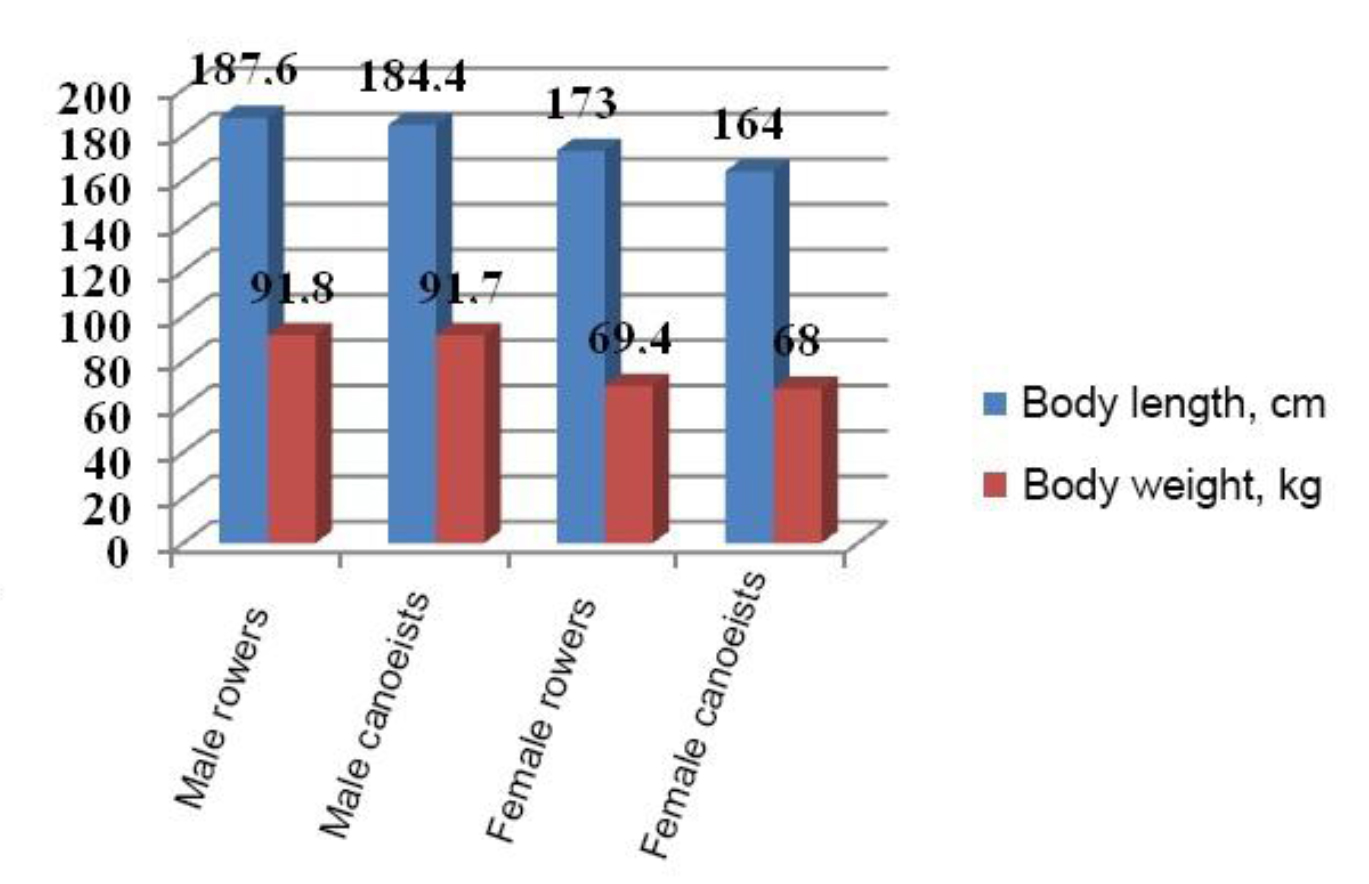
Fig. 1. Indices of body length and weight of the strongest rowers and canoeists
As seen from the comparison of these parameters, the highest body length indices were observed in male rowers (187.6±1.51), the lowest ones - in male canoeists (184.4±6.13), the differences were statistically significant (р<0.05). As for females, rowers had the highest body length indices (173.0±5.18), while canoeists - the lowest (168.7±4.37). The differences were statistically significant (р<0.001).
The biggest body weight was registered in male rowers (91.8±25.1), the smallest one - in male canoeists (91.7±6.74), as for females, the highest indices were marked in rowers (69.4±4.74), the lowest - in canoeists (68.0±1.01). The differences were not significant both in the male and female groups (р>0.05).
The largest vital capacity was observed in male rowers (6057.0±950.9), the smallest one - in male canoeists (5723.1±920.9), the same trend was observed among females, where the highest values were registered in rowers (3886±338.5), the lowest - in canoeists (3300±202.0). The differences were significant both in the male and female groups (р<0.05).
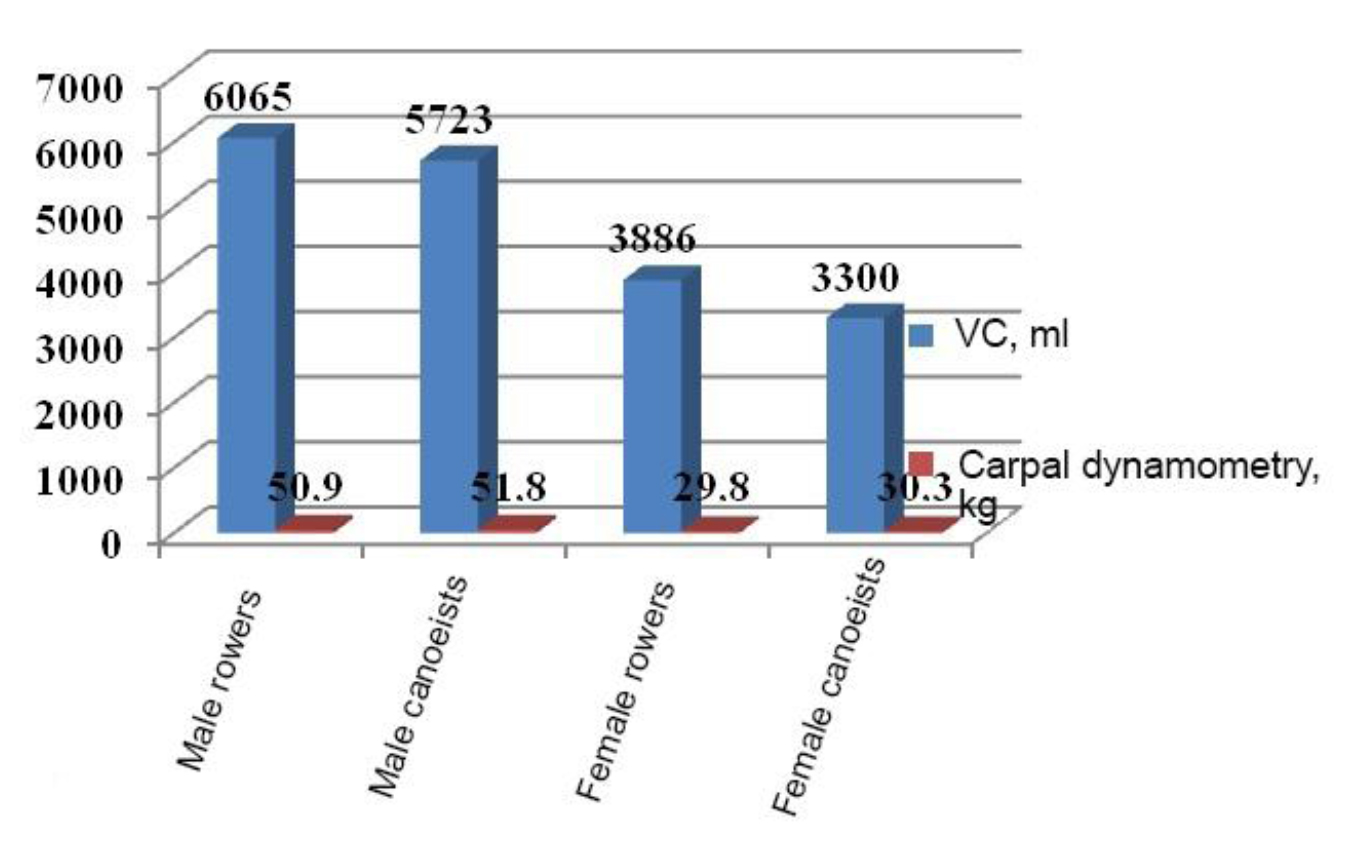
Fig. 2. Indices of vital capacity (ml) and carpal dynamometry of the strongest hand (kg), of the strongest rowers and canoeists.
The highest indices of carpal dynamometry of the strongest hand were marked in male canoeists (51.8±11.04), the lowest - in rowers (50.9±11.9), among females the same trend was observed: it is canoeists who had the highest indices (30.3±3.70), and rowers who had the lowest ones (29.8±3.70). The differences were insignificant both in the male and female groups (р>0.05).
The indices of the components of the body mass composition of the strongest rowers and canoeists are presented in Fig. 3.
Proceeding from the analysis of Table 3, the lowest values of absolute fat mass (kg) belonged to male rowers (8.08±2.01), the highest - to male canoeists (8.68±2.82), a similar trend was observed among females: the lowest values of absolute fat mass (kg) were registered in rowers (9.30±2.49), the highest - in canoeists (10.02±1.64). The differences were insignificant both in the male and female groups (р>0.05).
The lowest values of relative fat mass (%) belong to male canoeists (9.62±2.49), the highest - to male rowers (9.94±3.42). The differences were not significant (р>0.05). Among females it is rowers who had the lowest values of relative fat mass (%) (13.21±3.63), and canoeists who had the highest ones (14.72±1.49). The differences were not significant (р>0.05).
The highest indices of absolute muscle mass (kg) were marked in male canoeists (49.00±3.72), the lowest - in male rowers (47.61±2.21). The differences were statistically significant (р<0.05). Among females the highest indices were registered in rowers (35.51±3.02), the lowest - in canoeists (35.47±2.04). The differences were insignificant (р>0.05).
The highest indices of relative muscle mass were observed in male canoeists (53.85±1.95), the lowest ones - in male rowers (52.70±1.87). The differences were not statistically significant (р>0.05). Among females the highest indices were found in canoeists (52.18±3.05), the lowest - in rowers (51.15±2.77). The differences were insignificant (р>0.05).
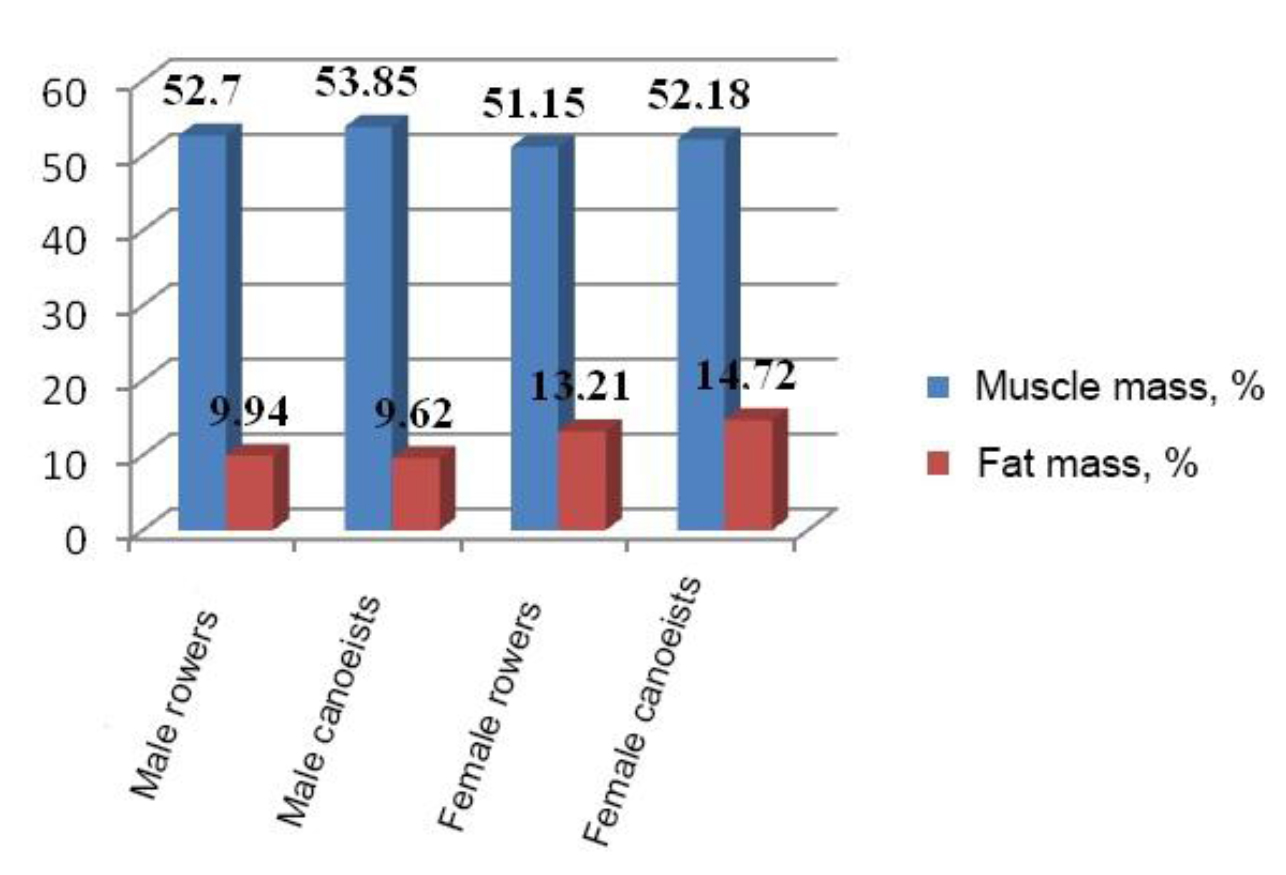
Fig. 3. Components of body mass composition of the strongest rowers and canoeists (%).
The results of the Popescu's test are presented in Fig. 4. The highest values of arm span were registered in male canoeists (200.0±4.60), the lowest - in male rowers (189.3±10.4). The differences were statistically significant (р<0.05). Among females the highest values of this index belonged to rowers (175.7±5.19), the lowest ones - to canoeists (167.0±7.74). The differences were significant (р<0.05).
It is male canoeists (151.4±3.37) who had the longest body length in the sitting position with arms extended straight up, and male rowers who had the shortest one (148.8±6.44). The differences were significant (р<0.05). Among females the highest values were marked in rowers (136.6±2.96), the lowest ones - in canoeists (133.5±4.21). The differences were statistically significant (р<0.05).
The longest body length in the sitting position up to the 7th cervical vertebra was marked in male rowers (72.7±1.84), the shortest - in male canoeists (70.6±0.31). The differences were significant (р<0.05). As for females, the same trend was observed in rowers who had the highest indices (65.1±2.70), the lowest - in canoeists (62.3±2.09). The differences were significant (р<0.05).
The morphofunctional state of rowers and canoeists was assessed using special scales to determine the morphofunctional suitability of boys and girls aged 10-18 for rowing and canoeing classes by the technology of V.Yu. Davydov et al. [4]. The final estimate of the morphofunctional state was calculated as a mean score from the total estimates in all features of the scale.
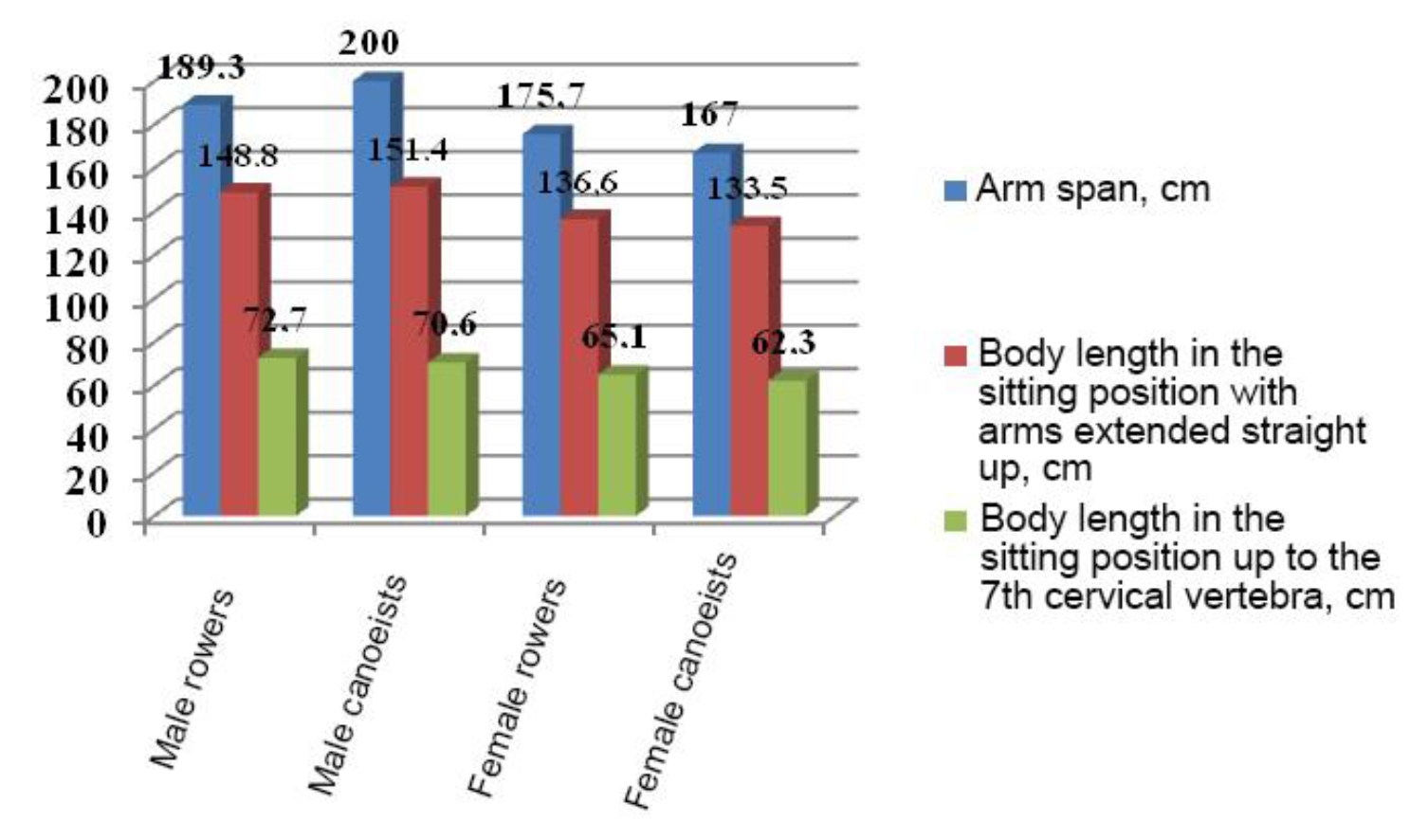
Fig. 4. Popescu's testing of the strongest rowers and canoeists
The majority of the examined athletes of both sexes (Table 3) were proved to belong to the above average level of morphological state – 61.90%, 4.30% of the contingent – to the high level of morphological state, and 23.8% of athletes – to the average level of morphological state; we did not register the cases of the low or below average levels of morphological states.
Table 3. Morphofunctional state of elite rowers and canoeists
|
Morphological state |
⅀ |
Low |
Below average |
Average |
Above average |
High |
|||||
|
n |
n |
% |
n |
% |
n |
% |
n |
% |
n |
% |
|
|
Rowers♂ |
14 |
- |
- |
- |
- |
2 |
14.29 |
8 |
57.14 |
4 |
28.57 |
|
Canoeists♂ |
12 |
|
|
|
|
2 |
16.67 |
8 |
66.66 |
2 |
16.67 |
|
Rowers♀ |
7 |
|
|
|
|
2 |
28.57 |
5 |
71.43 |
- |
- |
|
Canoeists♀ |
9 |
|
|
|
|
4 |
44.45 |
5 |
55.55 |
- |
- |
|
⅀ |
42 |
|
|
|
|
10 |
23.80 |
26 |
61.90 |
6 |
4.30 |
Integral estimation of the functional state of the strongest rowers and canoeists
The obtained data indicate that in athletes, who develop their endurance, when under training loads in the aerobic power mode, external respiration and respiratory metabolism are more efficient in terms of muscular work than in other examined individuals, as seen by the changes in the indices of oxygen consumption (DO2I, СI) (Table 4). The increase in the oxygen consumption indices DO2I and CI after loads was higher in athletes with higher sports qualification, irrespective of athletes' sex and specialization. The increase in the oxygen delivery index DO2I and CI, in relation to the control group, was significantly higher in athletes with the qualification of honored masters of sport (by 134.8 and 0.92 c.u. respectively), MSIG (by 127.4 and 0.76 c.u. respectively), MS (by 89.5 and 0.32 c.u. respectively), р<0.05 (Table 5).
Table 4. Oxygen consumption of rowers and canoeists after work in the aerobic power mode depending on their qualification in relation to the control group
|
Indices |
Athletes' qualification |
||
|
HMS |
MSIG |
MS |
|
|
DO2I, ml/min/m2 |
134.8 |
127.4 |
89.5 |
|
CI, l/min/m2 |
0.92 |
0.76 |
0.32 |
Note: *р<0.05
The use of inotropic, rather than chronotropic, reserve of the heart, resulting in a pronounced increase in the index of myocardial contractility (IMC), is an effective compensatory reaction in athletes' hemodynamics in response to exercise. The dynamics of the increment in MCI during endurance training was more pronounced in athletes with higher qualification at rest, rather than in the reserve and examined control group. The obtained data testify that MCI, when training in the aerobic power mode, increased in rowers compared with the control group. In athletes qualified as masters of sport of international grade (MSIG) and honored masters of sport (HMS) by 12.9 and 14.2 c.u. on the average respectively, in athletes qualified as masters of sport (MS) - by 9.1 c.u. The increment in MCI in the control group equaled 0.155 c.u. on the average, and generally, MCI in athletes was significantly higher (0.181- 0.204 c.u.), р<0.05 (Table 5).
Table 5. Increment in the indices of myocardial contractility of rowers after work in the aerobic power mode depending on qualification, in relation to the control group
|
Indices |
Athletes' qualification |
||
|
HMS |
MSIG |
MS |
|
|
MCI, 1000/sec |
14.2* |
12.9* |
9.1 |
|
IIS, l/sec2 |
0.34* |
0.16 |
0.14 |
|
HR, bpm |
52* |
63 |
65 |
Note: *р<0.05
The analysis of the results of determination of the baseline indices of the cardiovascular system revealed the lower level of HR in qualified athletes under rest conditions, which is the result of the regular sports training and is associated with the change of the autonomic regulation of heart and predominant influence of the parasympathetic outflow to the heart rhythm.
While studying the dynamics of HR in rowers with the qualification of MSIG and HMS, the HR level was on the average lower, and MCI was higher than in athletes with the qualification of masters of sport, р<0.05 (Table 6).
The increment in the indices of oxygen consumption (DO2I, CI) in the group of canoeists was positively correlated with their working capacity in the aerobic power mode and amounted to rs= +0,54 (р<0.05), in relation to the control group, irrespective of the level of athletes' qualification (Table 6).
Table 6. Increment in the myocardial contractility indices of canoeists after work in the aerobic power mode depending on qualification, in relation to the control group
|
Indices |
Athletes' qualification |
||
|
HMS |
MSIG |
MS |
|
|
DO2I, ml/min/m2 |
104.8* |
98.1* |
97.9* |
|
CI, l/min/m2 |
0.48* |
0.41 |
0.38 |
|
MCI, 1000/sec |
14.2* |
12.9* |
9.1 |
|
IIS, l/sec2 |
0.26 |
0.22 |
0.19 |
|
HR, bpm |
49* |
60* |
60* |
Note: *р<0.05
Consequently, under physical load, rowers and canoeists with higher physical working capacity had a complex of cardiorespiratory reactions formed focused on maintenance of the most effective level of performance of the systems providing gas exchange.
During the study we also determined a positive correlation between the level of increment in MCI of athletes and the level of their success in sport (Table 6): rowers of higher qualification (MS and MSIG) had the correlation coefficient equal to rs=+0,67, rowers with the qualification of MS it was rs=+0,47, in relation to the control group (р<0.01). In addition, in the testees from the control group no significant correlation between MCI and the level of physical working capacity was determined (Table 6), while among athletes of higher qualification higher MCI level promoted higher correlation coefficient (rs) between the mentioned indices: in the group of HMS rs= +0.61 (р<0.01) and in the group of MSIG rs= +0.68 (р<0.01), in the group of athletes with the qualification of MS rs= +0.40 (р<0.05), in relation to the control group.
The results of estimation of the functional state of the cardiovascular system depending on the level of athletes' sports qualification are presented in Table 8.
Table 8. Estimation of the functional state of qualified rowers and canoeists based on the results of the study of cardiac hemodynamics indices using the hardware system "SIMONA 111"
|
Indices |
Estimation of athletes' functional state |
||
|
High FS |
Average FS |
Low FS |
|
|
DO2I, ml/min/m2 |
900-1100 and higher |
700-900 |
below 700 |
|
CaO2, ml/100 ml |
22-23 |
20-21 |
18-19 |
|
SpO2, % |
98 and higher |
96-97 |
below 96 |
|
CI, l/min/m2 |
before load - 3.5-4.0 after load - 4.5-5.0 and higher |
before load - 3.0-4.0 after load - 4.5-5.0 |
before load – below 3.0 after load - 3.0-4.0 |
|
HR, 1/min |
before load – 55-65 after load – 70-80 |
before load – 45-70 after load – 75-85 |
before load – 70-85 after load – 60-90 |
|
MAP, mm Hg |
75-85 |
86-95 |
96-100 and higher |
|
MCI, 1000/sec |
after load - decrease to 40-50%, before load – increase by 30-40% of the initial level |
after load - decrease to 50-60% or increase to 30-40%, before load – increase by 30-40% of the initial level |
after load - increase to 50-60%, before load – decrease by 50-60% of the initial level |
|
IIS, 1/sec2 |
after load - decrease to 40-50%, before load – increase by 30-40% of the initial level |
after load - decrease to 50-60% or increase to 30-40%, before load – increase by 30-40% of the initial level |
after load - increase to 50-60%, before load – decrease by 50-60% of the initial level |
|
EDI, ml/m2 |
above 100 |
90-99 |
below 90 |
|
kNm, c.u. |
after load – increase by 30-40% of the initial level |
after load – increase by 50-60% of the initial level |
after load – increase by 50-60% of the initial level, accompanied by decrease of MCI and IIS |
|
CR, c.u. |
above 7.0 |
5.0-6.9 |
below 5.0 |
|
AR, c.u. |
above 1000 |
700-999 |
699 and lower |
The study has revealed a significant positive correlation of the genotype 34SS gene encoding the muscle isoform of adenosine monophosphate deaminase (AMPD1) (rs17602729) with high levels of the index of myocardial contactility in elite athletes (Honoured masters of sports and masters of sport of international grade), both rowers and canoeists (Table 7). In the total sample of athletes we determined the following regularity for the AMPD1 gene: the MCI in the carriers of the 34C allele was on the average equal to 80.4 c.u. in rowers irrespective of their sex and to 78.2 c.u. in canoeists. In the carriers of the 34T allele – 59.3 c.u. in rowers irrespective of their sex and 70.8 c.u. in canoeists (р<0.01) (Table 9).
Table 9. Distribution of allele frequencies of the studied genetic markers and their association with the indices of hemodynamics in the total sample of elite rowers and canoeists
|
Locus |
Alleles |
Frequency |
Indices of hemodynamics |
||
|
DO2I, ml/min/m2 |
MCI, 1000/sec |
СI, l/min/m2 |
|||
|
AMPD1 С34T |
34С |
0.5577± 0.0487 |
1067.3±4.2 (r) 954.4±5.8 (c) |
80.4±2.5 (r) 78.2±4.4 (c) |
4.0±0.7 (r) 3.8±1.2 (c) |
|
34Т |
0.4423± 0.0487 |
764.5±3.2 (r) 752.5±3.9 (c) |
59.3±2.4 (r) 70.8±4.0 (c) |
2.9±0.8 (r) 1.7±1.1 (c) |
|
Note: r - rowers; c - canoeists
The obtained results of the study suggest the indirect effect of the AMPD1 gene products on the cardiovascular system. Substitution of cytosine for thymine in the 34 position of the AMPD1 gene is associated with the change of the quality of the adenosine monophosphate deaminase products, increasing the energetic capacity of the heart muscle cells, vessels and bronchial tree. Most probably, the effects of the C34T polymorphisms of the AMPD1 gene on the studied indices of the cardiovascular system are mediated through the effects of resynthesis of ATP.
Estimation of the intensity of psychological defense in the strongest rowers and canoeists when training for international competitions
As follows from the examination of the members of the national rowing and canoeing team of Belarus, the total psychological defenses were detected in 60% of the examined athletes (the average level), herewith, in 40% of athletes this phenomenon did not exceed the diagnostic value (the low level) (Fig. 5).
We determined the level of intensity of each of the studied psychological defense mechanisms in the examined athletes (Table 10).
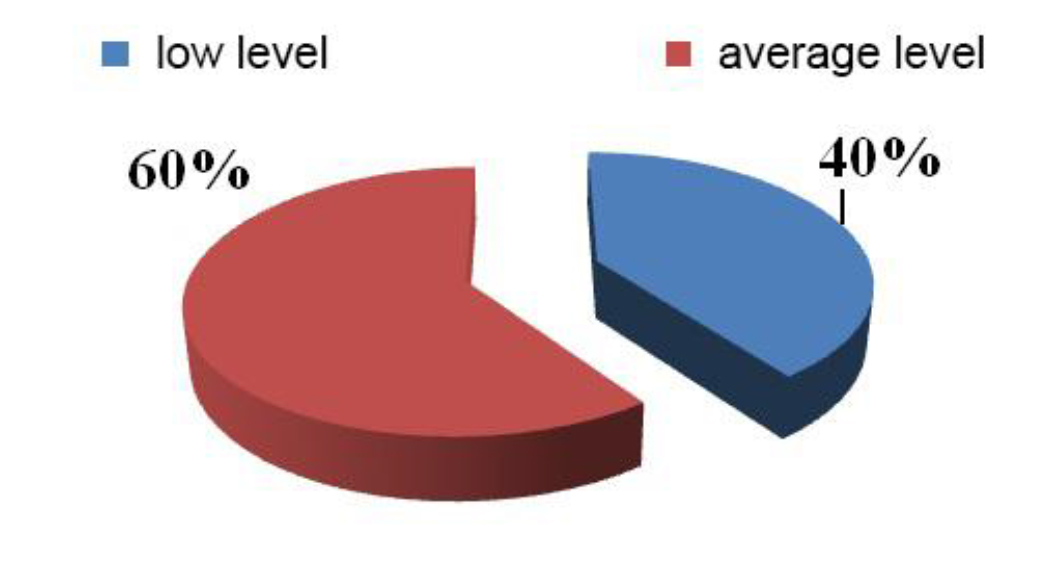
Fig. 5. Cumulative psychological defense in the athletes from the national team in rowing and canoeing
Table 10. Classification of psychological defense by intensity in the athletes from the national team in rowing and canoeing depending on the mechanism
|
Type of psychological defense |
Low level, n=25 |
Average level, n=25 |
High level, n=25 |
|
Denial |
20% |
68% |
12% |
|
Repression |
76% |
24% |
0% |
|
Regression |
96% |
4% |
0% |
|
Compensation |
56% |
40% |
4% |
|
Projection |
28% |
48% |
24% |
|
Displacement |
68% |
28% |
4% |
|
Intellectualization |
16% |
64% |
20% |
|
Reaction formation |
76% |
12% |
12% |
As follows from the obtained data, it is denial and intellectualization that are of great importance with the increase of psychological defense. It is a prognostically favorable variant of development of the phenomenon of adaptation. Certain diametric opposition of the mechanisms of defense formation is probably acquired by the examined individuals in the long age corridor.
High indices of the projection mechanism, however, are not critical for the development of performance, but they reflect certain assortative traits of "sports" temperament. Distribution of the psychological defense by patterns is presented in Table 11.
Table 11. Significance of psychological defense pattern
|
Psychological defense paattern |
Pattern significance |
|
Destructive types of psychological defense: repression, projection |
23% |
|
Moderately valid types of psychological defense: denial, regression, displacement |
62% |
|
Constructive types of psychological defense: compensation, intellectualization, reaction formation |
25% |
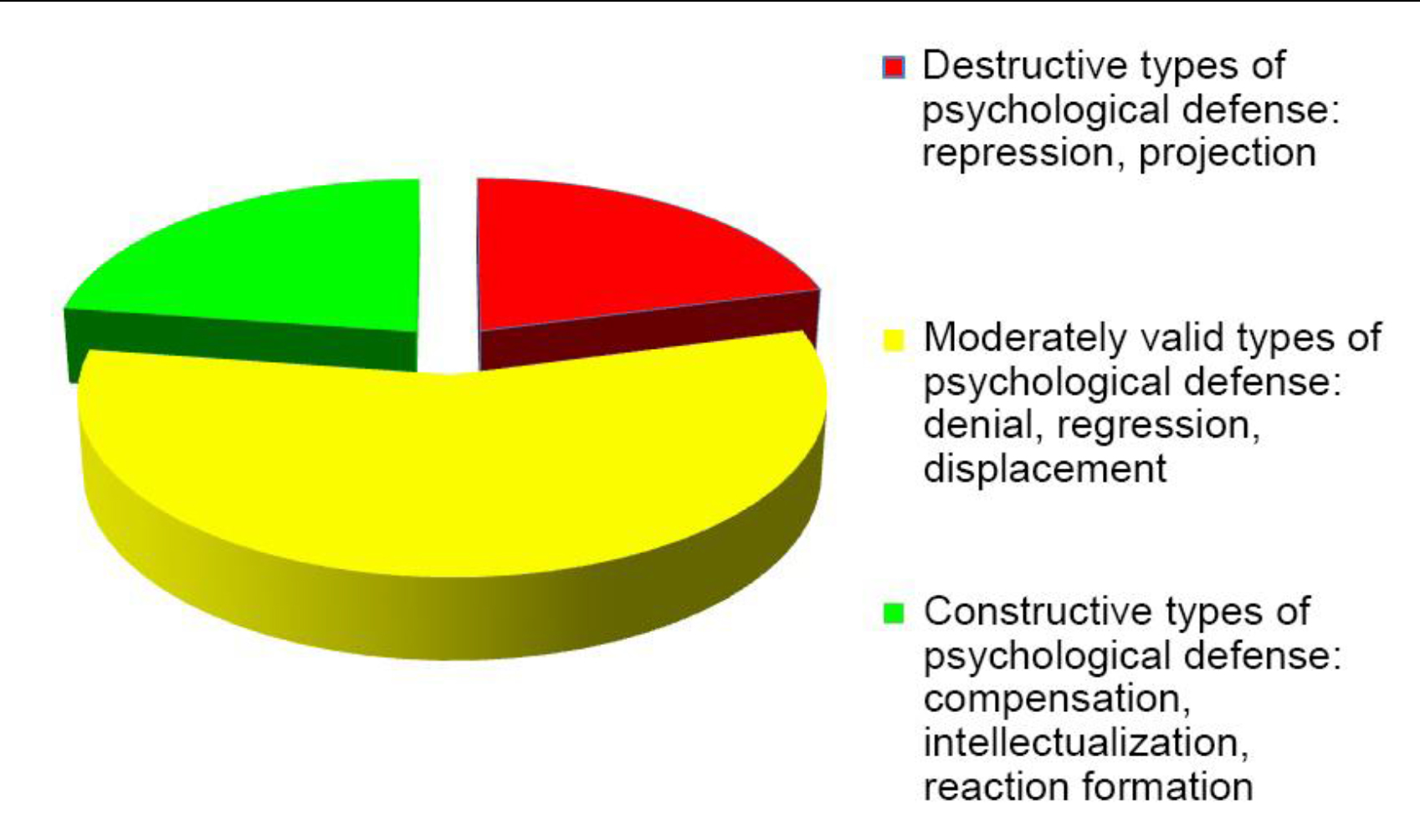
The obtained data have shown the high level of sports qualification, favorable conditions for the training process, efficient work of the coaching and medical staff of the national team. Under current conditions, the efficiency of the end result is certainly represented by the competitive success of the national team in rowing and canoeing.
In addition to the study of morphological indices, psychological state and function of the cardiovascular system, neurophysiological characteristics of elite athletes were studied in the research.
The features of neurophysiological characteristics of elite athletes have been detected, among which the values of vibration sensitivity (11.5 ± 1.2 s), maximum amplitude of oscillations for triceps (9000 ± 280 mV), single contraction time for triceps (375 ± 55 ms), biceps (805 ± 257 ms), speed of propagation of excitation in the median (63.5 ± 2.4 m/s) and ulnar nerves (62.2 ± 1.2 m/s). Elite athletes were observed to have a distinct alternation of contraction of the antagonistic and agonistic muscles, including biceps and triceps, when performing exercises on an ergometer, which was not marked in athletes of lower qualification.
Conclusions:
1. The conducted integrated study enables us to give a general estimation of the level of morphofunctional development of the strongest rowers and canoeists and give practical recommendation to trainers regarding individual correction of the training process.
2. We established the parameters of morphofunctional characteristics and indices of the components of the body mass composition of the strongest qualified rowers and canoeists of both sexes aged 17-35.
3. The majority of the examined strongest rowers and canoeists, males and females, were proved to belong to the above average level of morphological state – 61.90%; 4.30% of the contingent – to the high level of morphological state; 23.8% of athletes – to the average level of morphological state; the cases of the low or below average levels of morphological states were not registered.
4. The indicators, characterizing athlete's state during training in the aerobic power mode, include oxygen delivery index (DO2I), the increase of which is directly correlated with the increase of the perfusion blood flow volume - cardiac index (l/min/m2) (CI) and testifies to the efficiency of endurance training in the aerobic power modes in the group of rowers and canoeists.
5. An increase or decrease in the index of inotropic state (l/sec2) (IIS) and myocardial contractility index (103* l/sec) (MCI), at high kNm, after load testify to the low functional state of rowers and canoeists, overtraining, insufficient recovery after load. A decrease of IIS, MCI, at low kNm, after endurance load in the aerobic power modes, and further recovery of MCI, IIS within 24 hours testifies to the high functional state of athletes.
6. The high value of the left ventricular end-diastolic index (ml/m2) (EDI) in athletes testifies to their high working capacity.
7. The potentialities of myocardial contractility in rowers and canoeists are fixed in the genetic apparatus of their cells. The carriers of the 34C allele of the AMPD1 gene have higher values of the cardiac inotropy index - MCI.
8. The indicators of the genetic aspect of the potentialities of energy supply of physical load and hemodynamic state of the skeletal and cardiac muscles, along with the indicators of athletes' functional state, can be taken into consideration for the purpose of correction of the educational aspect of training to ensure using an athlete's individual potential without risk of injury and overtraining during sessions.
9. The dynamics of development of psychological defense with the growth of the fitness level and endurance should not reduce the extent of "the ceiling value" – the limit of the physiologically possible adaptive potential in the process of mobilization of endogenous mechanisms of enforcement of the end sports result.
References
- Antonov, A.A. Beznagruzochnaya otsenka funktsional'nogo sostoyaniya organizma sportsmenov (Loadless evaluation of functional state of athletes) / A.A. Antonov. – Russian Medical Academy of Postgraduate Education. – 2010. – 13 P.
- Bunak, V.A. Antropometriya (Anthropometry) / V.A. Bunak. – Moscow: Uchpedgiz, 1941. – 250 P.
- Davydov, V.Yu. Teoreticheskie osnovy sportivnogo otbora i spetsializatsii v olimpiyskikh vodnykh vidakh sporta distantsionnogo kharaktera: avtoref. dis. … dokt. biol. nauk (Theoretical Foundations of sports qualification and specialization in Olympic distance water sports: abstract of doctoral thesis (Biol.) / V.Yu. Davydov. – Moscow: MSU, 2002. – 40 P.
- Davydov, V.Yu. Morfologicheskie kriterii otbora v greblyu na baydarkakh i kanoe (Morphological criteria for qualification in rowing and canoeing) / V.Yu. Davydov, Yu.M. Sozin, V.V. Prokhorenko / Method. recom. – Volgograd, 1990, – 23 P.
- Davydov, V.Yu. Otbor i orientatsiya plovtsov po pokazatelyam teloslozheniya v sisteme mnogoletney podgotovki (Teoreticheskie i prakticheskie aspekty): monografiya (Qualification and orientation of swimmers in terms of constitution in long-term training (theoretical and practical aspects): monograph) / V.Yu. Davydov, V.B. Avdienko – Moscow: Sovetsky sport, 2014. – 384 P.: illus.
- Martirosov, E.G. Morfologicheskiy status cheloveka v ekstremal'nykh usloviyakh sportivnoy deyatel'nosti (Morphological status of a person in extreme conditions of sports activity) / E.G. Martirosova // Itogi nauki i tekhniki: Antropologiya, V. 1. – Moscow, 1985. – P. 100–153.
- Timakova, T.S. Mnogoletnyaya podgotovka plovtsa i ee individualizatsiya (Long-term training of swimmer and its individualization) / T.S. Timakova. – Moscow: Fizkul'tura i sport, 1985. – 144 P.
- Basset L.R.Jr., Howley E.T. Limiting factors for maximum oxygen uptake and determinants of endurance performance // L.R.Jr. Basset, E.T Howley. – Med. Sci. Sports Exerc. – 2000. – 32. – P. 70–84.
- Ferguson, S., Gledhill, N., Jamnik, V.K. Cardiac performance in endurance-trained and moderately active young women // S. Ferguson, N. Gledhill, V.K. Jamnik. – Med. Sci. Sports Exerc. – 2001. – 33. – P. 1114–1119.
- Matiegka, J. The testing of physical efficiency. – Amer., Journal of Physiol. Antropol. – 1921, v. 4. – P. 133–230
- Oakley, D. The athlete’s heart // D. Oakley. – Heart. – 2001. – 86. – P. 722–726.


